This was published 2 years ago
‘Would you come here for a weekend? Would you bring your kids?’ Fears lead mine will damage tourism
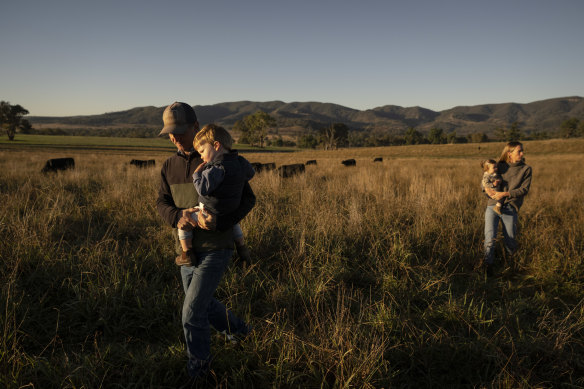
Jack and Susannah White, with their children Sid, 2, and Rosie, 1, on their farm outside Mudgee.Credit: Wolter Peeters
Susannah and Jack White have spent years fighting a proposed lead, zinc and silver mine near their farm outside Mudgee, but the couple cannot bring themselves to discuss what they will do if the mine gets approved this week.
“I don’t know. We haven’t even talked about it because it’s too hard,” Susannah says, glancing towards her husband, who looks down at the dining room table. The couple’s son and daughter are sleeping nearby, in the farmhouse their great-grandparents built.
“I’m a parent before anything else,” Susannah adds finally. “If my children’s health is at risk, that will be the determining factor. ”
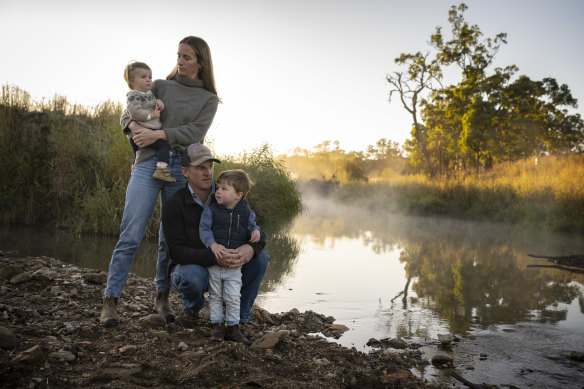
The White family fear for their future if a silver, zinc and lead mine is approved.Credit: Wolter Peeters
The Whites’ beef farm is about eight kilometres downstream of the proposed Bowdens Silver mine near the village of Lue, 30 kilometres outside Mudgee, on the tourist route to Rylstone. The couple worry about lead contamination from the mine and changes to the valley’s water supply, on which their farm relies.
The Independent Planning Commission is due to decide this week if the mine should be approved, after receiving more than 1000 submissions about the project. About 70 per cent of earlier submissions to the Department of Planning and Environment supported the mine.
The project is expected to produce about 3.4 million ounces of silver a year, as well as 6900 tonnes of zinc and 5100 tonnes of lead. It is the largest undeveloped silver deposit in Australia.
Bowdens says it will not compete with local agriculture for water and that its peer-reviewed health risk assessment makes clear the project “presents no health risks (caused by lead or other factors) to the community”.
But Victoria’s chief environmental scientist Mark Taylor, appearing at a public hearing last month in his role as honorary professor at Macquarie University, said the mine “clearly presents a risk to communities” due to increased dust and lead concentrations.
The Department of Planning says the mine will provide royalty revenue to the government and jobs for the Central West as the region moves away from coal mining. It claims the project is approvable with conditions, including that Bowdens offers nearby residents blood lead level monitoring.

The village of Lue sits opposite the proposed mine site.Credit: Wolter Peeters
Susannah White, who is part of the Lue Action Group that opposes the mine, says it is unfair to ask the community to undergo such testing.
“Imagine doing that to a two-and-a-half-year-old on a routine basis,” she says.
Lara Altimira is worried too. She walks across her rambling cottage garden in Lue and points out the site of the proposed mine, two kilometres away.
“I don’t think I want to live here when the mine starts. I definitely won’t,” she says, as her four-year-old daughter, Esther, eats raspberries and looks for crickets.
“We grow heaps of our own food here. The garden is a big part of our life. But if the soil is contaminated with lead dust, and there’s contamination in the water, we’re not going to be able to grow things.
“It’s going to turn Lue into a bit of a ghost town … people won’t want to live here.”
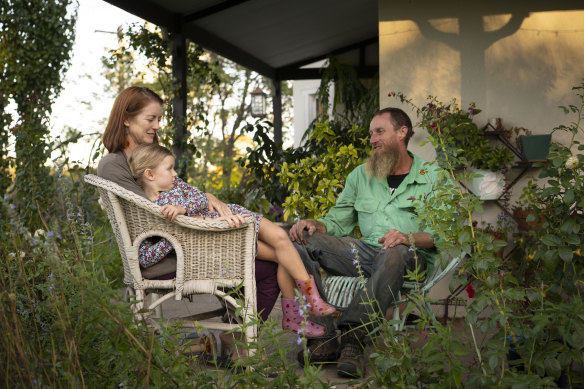
Lara Altimira, with partner Matt Brown and daughter Esther Brown, 4, live in Lue village, two kilometres from the mine site.Credit: Wolter Peeters
The village boasts about 40 homes, a pub co-owned by the mine’s managing director, and a primary school that last month received a heart defibrillator paid for by Bowdens. The miner has also sponsored other schools, sports clubs and events in the region, including the Mudgee Show and the Rylstone Bull A Rama.
Mudgee winegrower Gerry Norton-Knight, of Rosby Wines, says mining is critical to the region’s economy but the Lue proposal risks damaging the area’s reputation, its flourishing tourism industry, and the jobs that industry supports.
“We’re in a golden period. This is as good as it gets,” he says of Mudgee, sitting in the dappled shade outside the winery he started 30 years ago with his wife, Kay.
“We’ve become a magnet for young couples to bring up their families. We’re the envy of a lot of regional towns in Australia.
“If they get [the mine] wrong, we’ll go from being the best town to the worst town … Would you come here for a weekend, would you bring your kids, if there was a potential for lead issues?”
Locals have also been spooked by news linked to the Cadia copper and gold mine near Orange, which failed an air quality audit in November after a vent was found to be emitting 18 times the safe amount of respirable crystallised silica.
Residents within 15 kilometres of Cadia also say testing of their water tanks has found heavy metals, including lead. And Cadia’s operator, Newcrest, was fined $15,000 last year – the largest fine possible – for dust clouds that began after the mine’s tailings dam failed in 2018.
The Whites say miners should have to produce more detailed plans earlier in the planning process to show how they will manage pollution risks, and that too much is left to post-approval compliance, which is hard to enforce.
The couple were left disheartened late last week when the Independent Planning Commission approved the open-cut McPhillamys gold mine near Blayney, which had also sparked concerns about pollution, water supply, noise and the visual effect on the landscape.
The decisions come amid a push by state and federal governments to increase exploration and mining of minerals, as the country weans itself off coal and positions itself as a key supplier of critical minerals the world needs for technology, including for renewable energy.
The NSW Minerals Council says direct spending on metals mining has more than doubled in the past five years, to $2.4 billion last financial year. Many of the mine sites under exploration are “greenfield” sites that have never been mined before.
The Central West is also a key part of the state’s 2021 Critical Minerals Strategy, which aims to turn NSW into a leading supplier and processor of rare critical minerals used for technology, including for renewable energy.

The village of Lue sits opposite the proposed mine site.Credit: Wolter Peeters
But farmers fear the region’s agricultural land is being sacrificed to make way for the mining boom.
Blayney beef producers Rebecca and David Price are horrified the tailings dam for the McPhillamys mine, built to contain its residue, will be at the head of the Belubula River, on which they rely for water. They also fear the mine will cause the river to dry up by blocking its natural springs, hindering their farm’s operation.
The McPhillamys mine is expected to produce up to 2 million ounces of gold over 11 years out of a pit that will be more than a kilometre wide and 460 metres deep. The waste rock will be turned into a mound alongside.
”When are we going to stop ripping up perfectly good grazing country?” Rebecca says. “This is safe country that we should be preserving for when climate change rears its head and people are asking ‘where’s the food?’”
Mine owner Regis Resources plans to rehabilitate the site after use, although the pit and mound will remain. It says 94 per cent of the land will be returned to agriculture.
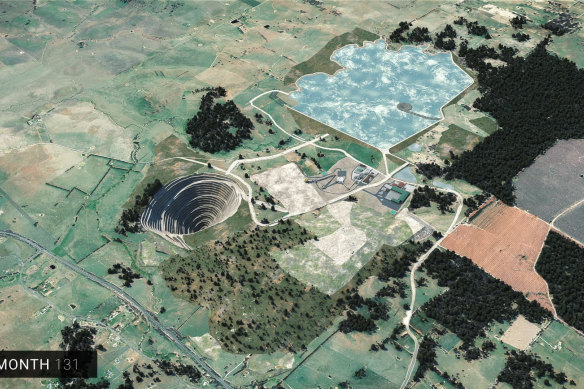
An illustration of the McPhillamys mine, with Kings Plain houses in the bottom left.Credit: Regis Resources
Approving the project, the Independent Planning Commission noted most submissions supported it, and the mine would meet growing demand for raw metals. It would also result in almost 1000 jobs, as well as produce $65 million in royalties.
But Kings Plains resident Daniel Sutton has objected to the project. He says he and his wife have delayed having children because of the uncertainty surrounding the mine.
“There is a very real possibility we won’t have children at all now. That has not been an easy realisation, and we have had many heated discussions about it, but that’s the reality we face.”
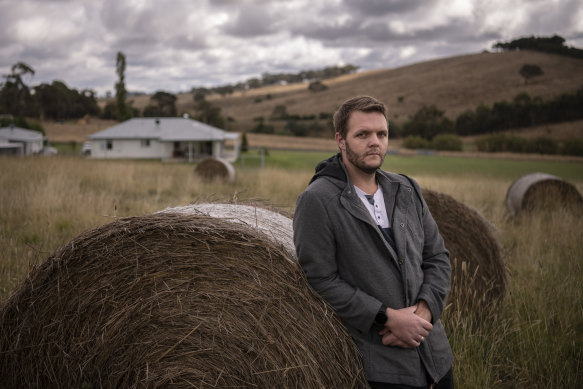
Daniel Sutton at his home in Kings Plains, with the mine site in the background.Credit: Wolter Peeters
He says the couple had no idea the hill across the road was full of gold when they bought their rural block of land in 2016, planning to turn it into their family home.
“There were cows on it,” he says. “We thought, ‘oh yeah, it’s someone’s farm.’“
He is frustrated the couple have lost so much for a metal he believes will most likely sit in a bank vault. Only about 8 per cent of it is used for technology.
“It’s only gold,” he says, looking across at the mine site. “It’s not like we need it.”
Get to the heart of what’s happening with climate change and the environment. Our fortnightly Environment newsletter brings you the news, the issues and the solutions. Sign up here.